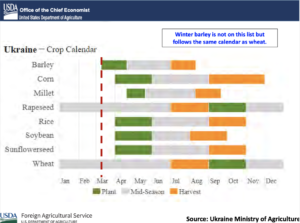China has bought at least 8 million tons of US soybeans this year, according to people familiar with the matter, putting the world’s top importer on track to meet a…
Ukrainian Farmers Plant First 150,000 Hectares, as Concerns Over Food Price Discontent Persist
Reuters writer Pavel Polityuk reported yesterday that, “Major global grain grower Ukraine has sown the first 150,000 hectares of spring crops amid the Russian invasion which could sharply reduce the sowing area, the country’s deputy agriculture minister said on Friday.
“Taras Vysotskiy said in a statement corn, soybeans, sunflowers, millet, buckwheat, oats and sugar beets were among the crops sown.”
The Reuters article noted that, “Ukraine’s agriculture minister Roman Leshchenko, who resigned on Thursday due to health reasons, told Reuters in an interview this week that 2022 spring crop sowing area may more than halve from 2021 levels to some 7 million hectares, versus 15 million hectares expected before the Russian invasion.
“Vysotskiy said he expected a decrease in the area sown with high-margin crops – sunflower and corn, but the area sown to ‘simpler crops in production, but important in terms of food security – peas, barley and oats will increase.'”

Meanwhile, New York Times writer Vivian Yee reported today that, “Ramadan arrives in a week: a festive season when people across the Middle East and North Africa normally look forward to gatherings with friends and family, new clothes and feasts that begin after sundown and stretch late into the night. But this year, prices of staples such as oil, sugar, flour and rice have surged across the region, thanks to global supply chain snarls and the war between Russia and Ukraine, which export many essential commodities and foods, including wheat, fertilizer and gas.
“That reality threatens to crush household and government budgets alike in countries that had nothing to spare, raising the possibility of the kind of mass popular unrest not seen since the Arab Spring protests a decade ago, which stemmed in part from soaring food prices.”
Thousands of innocent civilian deaths in Ukraine may be just the start of it warns @lhsummers who fears there might be "more deaths miles from Ukraine from potential food shortages and famines." Watch the full interview tonight at 6PM ET on #WallStreetWeek https://t.co/OJRS8ngRnP pic.twitter.com/Ju7m8Qmk3M
— Bloomberg TV (@BloombergTV) March 25, 2022
The Times article stated that, “Drought is already ravaging Morocco’s economy. Tunisia’s deeply indebted government was struggling to pay for wheat imports even before the war broke out. Lebanon is shuddering under an economic collapse. Syria, already raked by war and growing poverty, is now facing prices for tea and dates that have doubled or even tripled since last Ramadan, according to Damascus residents.
And in Egypt, where videos of ordinary people venting about food prices have gone viral on social media under the hashtag ‘revolution of the hungry,’ the government has been forced to move swiftly to blunt the blow.
“In a clear sign of the distress, Egypt on Wednesday announced that it had opened talks with the International Monetary Fund over a new financial assistance package, its third in six years, noting in a statement that the shock of the Ukraine war had caused prices to rise to ‘unprecedented’ levels and had sent foreign investors fleeing.”
And, Bloomberg writers Zainab Fattah and Salma El Wardany reported yesterday that, “The United Arab Emirates has accelerated a plan to invest billions of dollars in Egypt because it wants to ward off economic shocks from the war in Ukraine that could shake the stability of the Arab world’s most populous nation.
“A major food importer, Egypt’s been hit hard by record grain prices fueled by the Russian invasion. One of the Middle East’s most indebted nations, it buys most of its wheat from Russia and Ukraine, using those supplies as a cornerstone for a subsidized program providing cheap bread for 70 million people.”
“Wheat is more expensive now than in 2008, when the world saw food riots and demonstrations. Egypt needs to get ahead of any similar discontent, since about half of its people live near or below the World Bank’s poverty line,” the Bloomberg article said.
Also yesterday, Bloomberg opinion columnist Bobby Ghosh indicated that, “The price of wheat, already rising toward the end of last year, has skyrocketed with Russia’s invasion of Ukraine. The two countries are among the world’s biggest exporters of wheat and major suppliers of the Arab world.
“As a result, the price of bread has soared across the region. The World Food Program is warning of increased hunger everywhere, and human-rights organizations say the Middle East and North Africa are especially vulnerable because of their wheat-heavy diet. There have already been low-key protests over food prices in Iraq. In Lebanon, demonstrations against a collapsing currency have been sharpened by the simultaneous climb in bread prices.”





